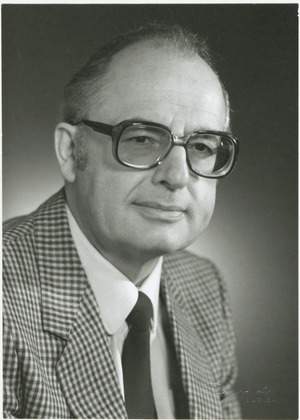Albert Eschenmoser facts for kids
Quick facts for kids
Albert Eschenmoser
|
|
|---|---|
 |
|
| Born | 5 August 1925 Erstfeld, Switzerland
|
| Died | 14 July 2023 (aged 97) |
| Alma mater | ETH Zurich |
| Known for | Eschenmoser's salt Eschenmoser fragmentation Eschenmoser sulfide contraction Eschenmoser–Claisen rearrangement Synthesis of vitamin B12 (along with Woodward) |
| Awards | Ernest Guenther Award (1966) Marcel Benoist Prize (1972) Davy Medal (1978) Wolf Prize in Chemistry (1986) |
| Scientific career | |
| Fields | Organic chemistry |
| Institutions | ETH Zurich |
| Thesis | Zur säurekatalysierten Zyklisierung bei Mono- und Sesquiterpenverbindungen (1952) |
| Doctoral advisor | Lavoslav Ružička |
| Doctoral students | Scott E. Denmark Ernst-Ludwig Winnacker Andreas Pfaltz |
Albert Jakob Eschenmoser (born August 5, 1925 – died July 14, 2023) was a famous Swiss chemist. He was best known for creating complex natural compounds in the lab. One of his biggest achievements was helping to make vitamin B12. This is a very important vitamin for our bodies.
Eschenmoser also did important work on how life might have started on Earth. He studied how simple chemicals could have formed the building blocks of life. He taught at ETH Zurich in Switzerland and The Skaggs Institute in California. He also visited many other top universities.
Contents
Making Vitamin B12
Albert Eschenmoser started his science journey at ETH Zurich. He worked with Leopold Ružička, a chemist who won a Nobel Prize. Eschenmoser's early work helped us understand how some natural substances, like steroids, are made.
In the 1960s, Eschenmoser became a professor. He then started working on vitamin B12. This was one of the most complicated natural products ever made in a lab at that time. He worked with another famous chemist, Robert Burns Woodward, from Harvard University.
About one hundred students and researchers worked together for many years. They faced a big challenge: how to close a large ring structure inside the vitamin B12 molecule. Eschenmoser and his team found new ways to connect these parts. They even used a special light process to join two important rings. This step was very precise.
In 1972, both teams finished making vitamin B12. This was a huge moment in the history of organic chemistry. Some chemical reactions and substances are named after him, like the Eschenmoser fragmentation and Eschenmoser's salt.
Research on Life's Beginnings
Eschenmoser also studied a big question: how did life first appear on Earth? One puzzle is why ribose sugar is used in DNA and RNA. These are the molecules that carry genetic information.
Eschenmoser found a way that ribose could have formed easily on early Earth. He showed that certain simple sugars, when mixed with phosphate, could create ribose. This gave clues about how the basic parts of DNA and RNA might have come to be.
Artificial Nucleic Acids
Eschenmoser created new types of nucleic acids in the lab. These are like DNA and RNA but have slightly different sugar parts. By making these "artificial" nucleic acids, he could compare them to natural ones. This helped scientists understand why DNA and RNA work so well.
His work showed that the shape of the sugar in DNA and RNA is very important. It helps the parts of the DNA molecule (called bases) stack up neatly. This stacking helps hold the two strands of DNA together. It also helps with the famous Watson-Crick base-pairing rules.
One artificial nucleic acid he invented is called Threose nucleic acid (TNA). TNA can also store genetic information. Some scientists think that TNA might have been an early form of genetic material. It might have existed before DNA and RNA on primitive Earth.
Death
Albert Eschenmoser passed away on July 14, 2023. He was 97 years old.
Awards
- Kern Prize of the ETH Zurich (1949)
- Werner Prize of the Swiss Chemical Society (1956)
- Ruzicka Prize of the ETH Zurich (1958)
- Ernest Guenther Award (1966)
- Davy Medal (1978)
- Wolf Prize in Chemistry (1986)
- Benjamin Franklin Medal in Chemistry (2008)
See also
 In Spanish: Albert Eschenmoser para niños
In Spanish: Albert Eschenmoser para niños


